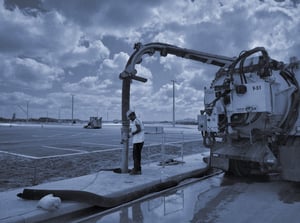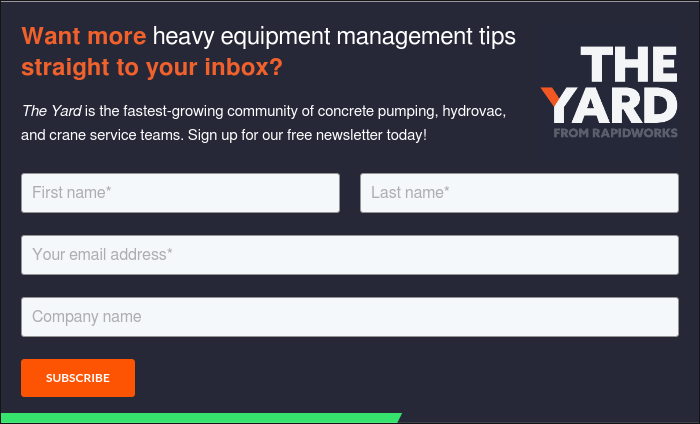
How to Extend the Life of Your Hydrovac Equipment
Like any heavy-duty machinery, hydrovac trucks only last as long as you care for them. Consistent heavy equipment maintenance prevents breakdowns and keeps your jobs running smoothly. It also extends hydrovac life and protects your bottom line.
It's simple math. Downtime is expensive: It leads to idling crews, shut down jobs, and frustrated customers. Less-than-optimal performance means running behind schedule. It also introduces safety hazards, as faulty construction equipment can contribute to 20% of all work fatalities.
This guide explains why preventive hydrovac maintenance matters and how to build a solid program to keep your equipment at peak performance.
We'll cover:
- Building a Comprehensive Hydrovac Maintenance Program
- Why Preventive Maintenance Matters
- What Should a Hydrovac Maintenance Program Include?
- Keeping Equipment Running at Optimal Levels
- How RapidWorks Can Help Simplify Maintenance
- FAQs About Hydrovac Maintenance
Building a Comprehensive Hydrovac Maintenance Program
A maintenance checklist is handy, but it is not enough to tackle all your equipment needs. A comprehensive maintenance strategy helps extend hydrovac life and keep it at peak performance.
What Is a Maintenance Program (And Why Is It More Than a Checklist)?
A lot of businesses operate with a maintenance schedule. It's usually a spreadsheet or a whiteboard with a few recurring tasks: check fluids, rotate tires, change filters. That's a good start, but it's only scratching the surface.
A maintenance program is a strategy. It considers how often your equipment is used, who's operating it, the environments it runs in, and the manufacturer's recommendations. It goes beyond just ticking tasks off a list. It helps you prevent problems before they start.
Investing the time to build this kind of program means fewer surprises, less downtime, and a healthier fleet long-term. That translates directly into dollars saved.
Why Preventive Maintenance Matters
Preventive maintenance of construction equipment is good business. It can be easy to "forget" about doing it or postpone it to squeeze in one more job, but that brings expensive repairs and downtime.
If you put off maintenance too long, you can do serious damage. It's cheaper to replace a worn hose than to rebuild an entire vacuum pump. Furthermore, when your truck is in the shop, your crew isn't working. That's lost contracts, delayed timelines, and frustrated clients. Every hour your equipment is out of service, you're losing money.
When you care for your equipment properly, you can extend its lifespan . Depending on your usage and the quality of your maintenance program, you can generally extend its lifespan between 7,000 and 10,000 operating hours — approximately five to 10 years of use.
You also protect the resale value of your equipment. Clean service records and a well-maintained truck fetch a better price if you ever decide to upgrade. Proof of preventative maintenance done consistently can command top dollar, as much as 30% to 40% of initial costs.
What Should a Hydrovac Maintenance Program Include?
Maintenance should be top of mind whenever you touch a piece of heavy equipment. You want to make sure it's safe for your workers and ready to do the job.
Weekly Tasks
- Check fluid levels: Low hydraulic, coolant, water, and oil levels can damage pumps and reduce vacuum performance.
- Clean debris tank and hose assemblies: Built-up sludge affects suction and airflow.
- Inspect the vacuum system: Look for pressure loss, clogged lines, or leaks.
- Lubricate high-friction parts: Bearings, PTO shafts, and seals need regular greasing.
- Truck inspection: Safety checks make sure everything works properly.
Monthly Tasks
- Tire check: Rotate tires and inspect tread wear.
- Inspect electrical systems: Check lights, fuses, and battery terminals.
- Tighten loose bolts and mounting brackets: Loose bolts and brackets can lead to accidents.
- Clean or replace air filters: A clogged air filter puts unnecessary strain on the engine.
Quarterly Tasks
- Run a diagnostics check: Use onboard systems or have your mechanic check things out.
- Change oil and filters: Keep the engine clean and running efficiently.
- Inspect the blower system for wear or drop in pressure: A drop in performance could signal bigger issues down the line.
- Replace worn seals or vacuum hoses: Prevent leaks that reduce suction and damage the system.
Annual Tasks
- Full DOT inspection: Ensure your truck meets all federal safety regulations.
- Clean tank and boiler: Descale the water tank and boiler system.
- Check the undercarriage: Look for damage and rust.
- Thorough review: Check and replace critical components that have hit their service life.
Each task reduces wear, prevents breakdowns, and keeps your equipment safe and productive.
Keeping Equipment Running at Optimal Levels
Hydrovac maintenance takes a team effort, which means your operators need training. For example, does everyone follow proper shutdown protocols at the end of the day, opening all drain valves to prevent buildup and air circulation (especially during the winter when things could freeze)?
Ensure Proper Equipment Training
Even the best equipment is going to degrade with bad habits. Training your operators can minimize wear and tear on your hydrovac equipment.
Start by standardizing your training. Having a hydrovac operations manual specific to your fleet and how you want to operate can help. This should cover startup, operations, and shutdown. Creating standard operating procedures (SOPs) and checklists in the cab can also be beneficial, as it keeps proper operations front and center for operators.
When everyone understands how to operate the equipment correctly, you'll see fewer avoidable repairs and better performance. You can even save on fuel, cutting down your operating costs.
Manage Wear and Tear Proactively
No matter what, wear and tear is unavoidable. These machines work hard, often in harsh conditions.
But you can control how quickly wear sets in and how you deal with it. Here are a few tips that can help:
- Don't overfill the tanks: Extra weight stresses suspension and blower systems.
- Warm up and cool down the engine: This protects critical internal components.
- Clean components after every use: Hoses, tanks, and valves need regular rinsing to avoid buildup.
- Use the correct water pressure: Too high and you'll damage fittings, too low and the job takes longer.
- Listen for vibrations: It can indicate loose or misaligned parts that, if ignored, can lead to major failure.
When operators see performance drop, don't wait. Even if it's not time for the next maintenance cycle, a noticeable change in performance levels means something's not right.
Don't forget to document everything you do. Detailed maintenance records can help you track what you're doing and anticipate when it's time to do work again. For example, if you see drop-offs in performance at consistent intervals, you can schedule rebuilds of your vacuums or pumps beforehand.
Prepare for Seasonal Demands
Your maintenance program should shift with the seasons. Hydrovac trucks face different challenges in extreme cold and heat, so your maintenance schedule can significantly influence performance and reliability. As we approach the upcoming summer months, keep the following tips in mind.
Summer Maintenance Tips
- Check cooling systems weekly: Overheating is more likely when temperatures are high.
- Monitor fluid levels more frequently: Summer means higher evaporation rates.
- Inspect electrical systems: Heat stress can crack insulation and degrade connections.
- Avoid the hottest parts of the day: If you're working in extremely hot areas, plan jobs earlier or later in the day.
Winter Maintenance Tips
- Use antifreeze in water systems: Also, drain lines completely if the truck will sit unused overnight.
- Keep trucks indoors or use heated wraps: Prevent freezing in the tanks and hoses.
- Run your boiler daily, even when not on jobs: Keeps internal systems from locking up.
- Apply undercoating: Protects the frame and components from road salt and moisture.
Build these seasonal adjustments into your program, and you'll see a major difference in downtime and repairs.
How RapidWorks Can Help Simplify Maintenance
Keeping track of maintenance manually can be overwhelming, especially with a growing fleet and a team of operators. With RapidWorks' all-in-one software for managing hydrovac jobs, you get the tools you need to manage your trucks, crew, and jobs all in one place, so you're always ready to answer the call.
RapidWorks products like Rapid Fleet are built with heavy equipment maintenance in mind to make sure you never miss important tasks. You can develop and manage preventative maintenance in a central system, building comprehensive maintenance plans based on service time, mileage, and more. You get automated alerts when service thresholds approach and can convert maintenance tasks to work orders to keep you on track.
GPS and telematics systems can pair with RapidWorks so you can automatically update odometer readings to track time to maintenance. The work order dashboard lets you quickly see which vehicles need attention and prioritize repairs, efficiently managing your work orders. You can also help your mechanics stay organized by assigning and completing preventative maintenance on the platform, building complete records for tracking.
See how RapidWorks simplifies job management. Forget the headaches and let's get to work.
Schedule a demo today and see how you can work smarter (and get paid faster).
FAQs About Hydrovac Maintenance
How often should I service my hydrovac truck?
Weekly for basic checks, monthly and quarterly for system inspections, and annually for deep maintenance. Adjust your schedules based on actual usage.
What's the most overlooked maintenance task that shortens equipment life?
Failing to clean out water tanks and hoses during winter. Ice can destroy internal systems if left unchecked.
Can digital hydrovac maintenance tools really help?
Digital tools like RapidWorks reduce human error, keep everyone accountable, and help spot patterns before they become problems.
What's the best way to train new operators on hydrovac maintenance?
Pair them with experienced crew members, use visual SOPs, and host regular review sessions to reinforce key practices.
What are the warning signs that a hydrovac is nearing failure?
Watch for reduced vacuum power, fluid leaks, overheating, sluggish performance, or odd noises from the blower or pump.
